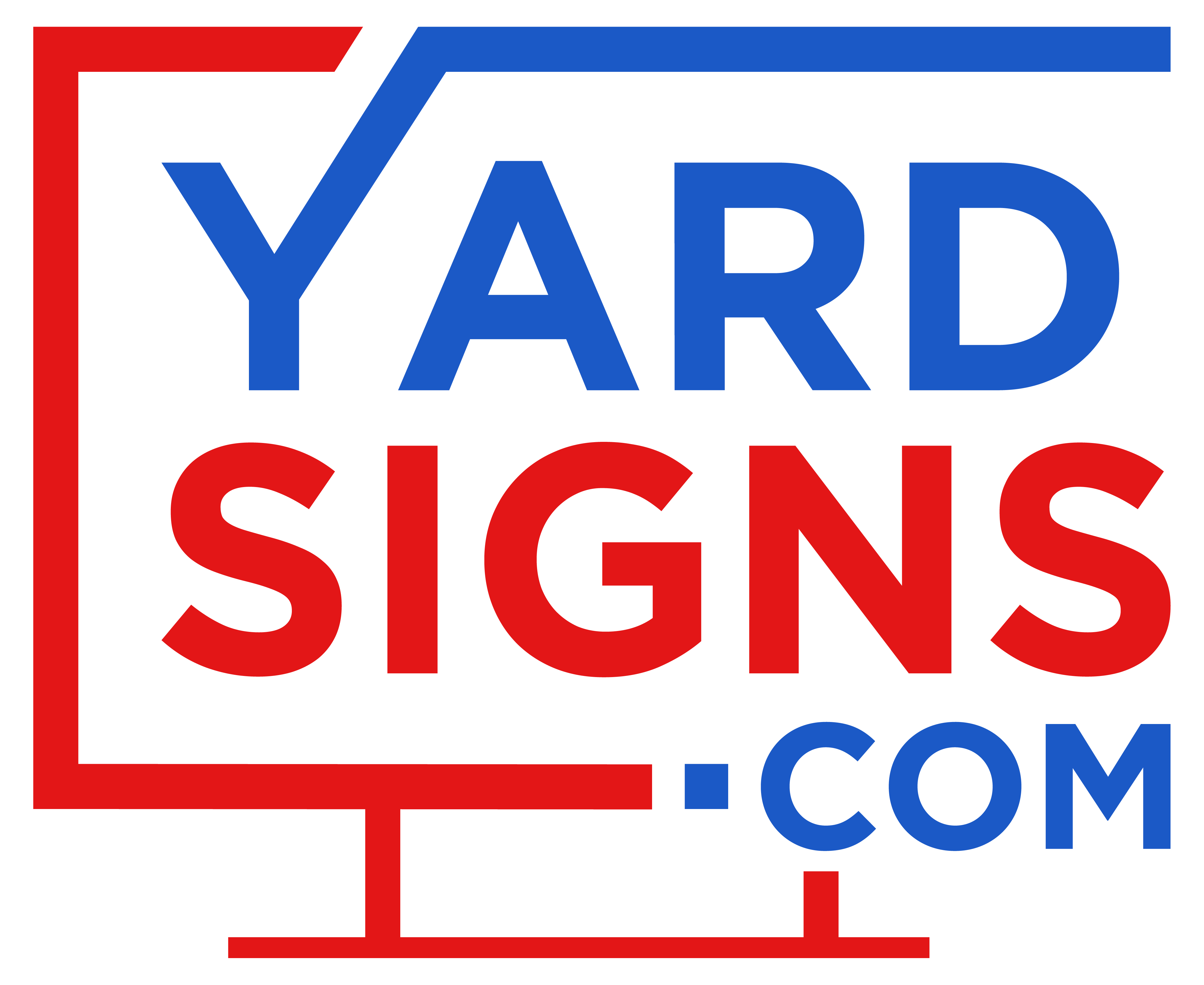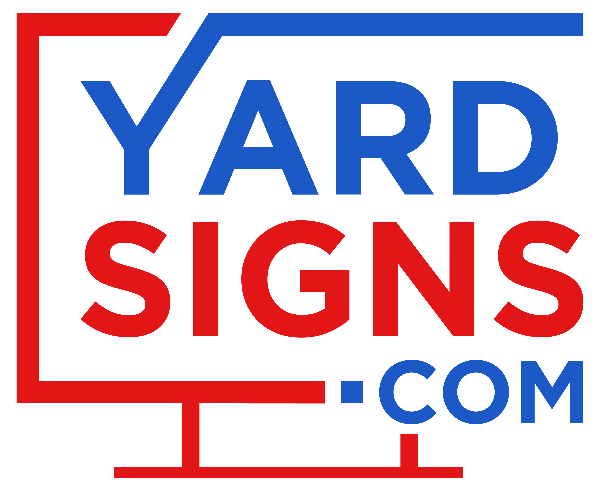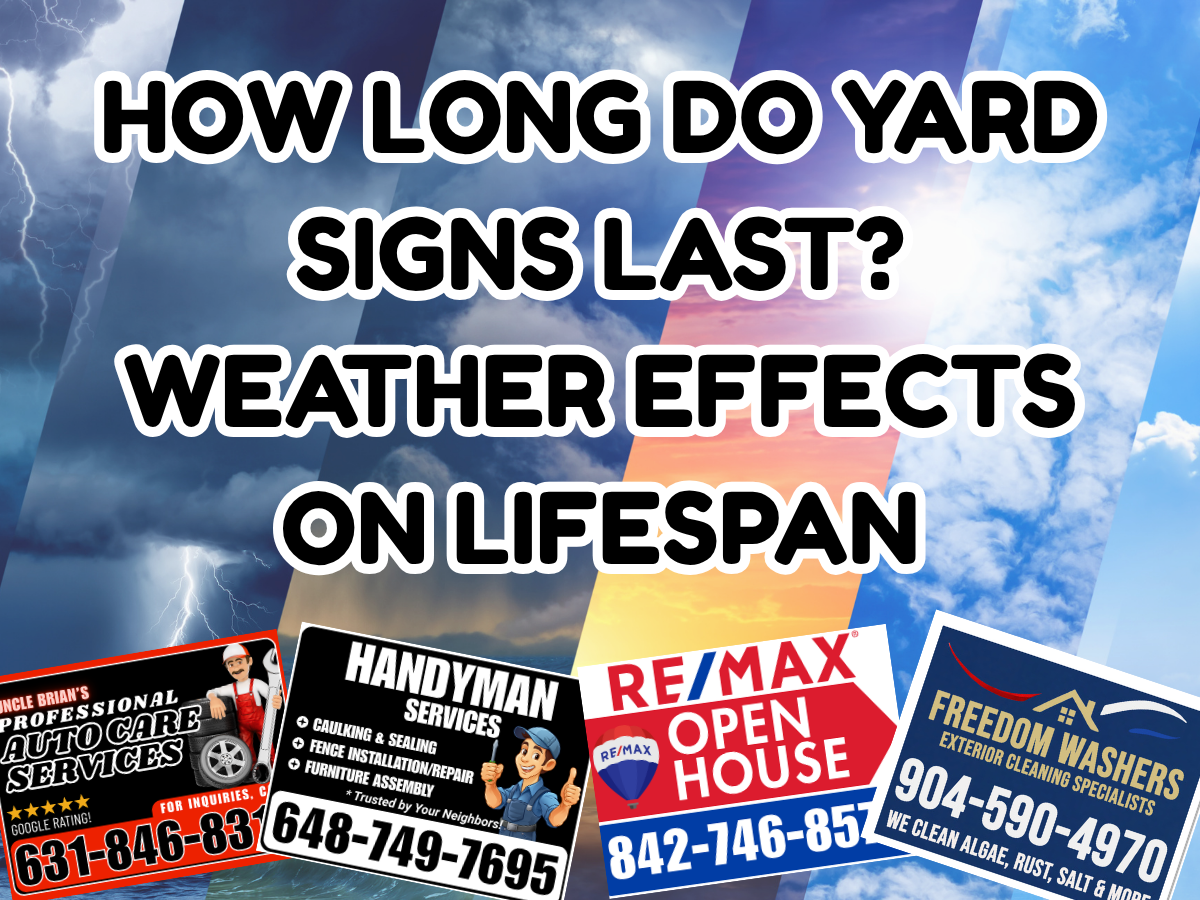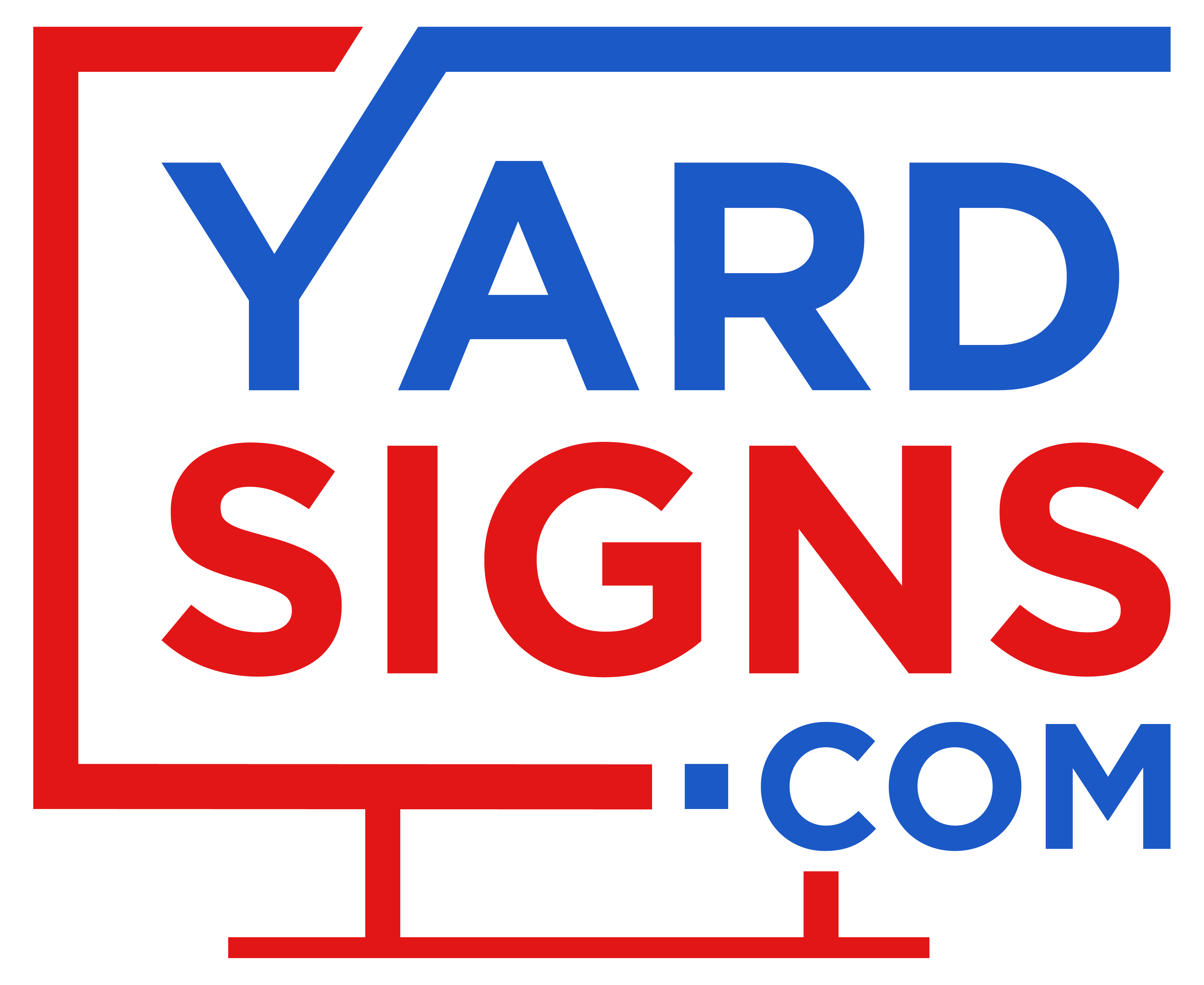Outdoor signs are exposed to a variety of weather conditions every day. Rain, sunlight, wind, and temperature changes all play a role in how long a yard sign will remain in good condition.
Some signs are designed to last only for a short time, such as during an event or campaign. Others are built with materials that hold up well for longer periods, even in harsh environments.
The material of the sign, the printing method, and how it's displayed all affect its durability. Understanding the average lifespan of different types of signs helps with planning and placement.
What Is the Typical Lifespan of Yard Signs Outdoors
Yard signs typically last between 6 months and 5+ years outdoors, depending on the material used and local weather conditions. The lifespan varies significantly based on several factors:
- Corrugated plastic signs: 6 months to 2 years outdoors
- Aluminum signs: 3 to 5+ years outdoors
- Vinyl signs: 6 months to 3 years (varies by quality and lamination)
Indoor use extends the life of all sign types considerably. A corrugated plastic sign that might last 1-2 years outdoors could last 5-10 years when used indoors, away from weather elements.
The primary factor affecting longevity is exposure to weather. Signs placed in harsh environments with extreme temperatures, strong winds, or intense sunlight deteriorate faster than those in moderate climates.
Key Weather Factors That Affect Durable Yard Signs
Four main environmental conditions determine how quickly yard signs wear out:
1. UV Exposure and Sunlight
Ultraviolet (UV) rays break down sign materials over time, causing colors to fade and surfaces to become brittle. This damage occurs even on cloudy days when UV rays still penetrate the atmosphere.
- Direction matters: Signs facing north, east, or west typically last 7-10 years, while south-facing signs receive more direct sunlight and deteriorate faster
- Color fading: The first visible sign of UV damage, especially in red, blue, and black inks
- Material breakdown: UV rays cause plastic to become brittle and crack over time
Modern UV-resistant inks can extend a sign's color vibrancy from 12 to 15+ months, making them worth considering for long-term outdoor displays.
2. Moisture and Humidity
Water damage affects signs in several ways. Rain, snow, and high humidity can seep into materials, causing warping, mold growth, and ink bleeding.
Signs of moisture damage include:
- Warping or bending of the sign material
- Mold spots, particularly in shaded areas
- Bleeding or running of printed colors
- Weakening at connection points where the sign attaches to stakes
Aluminum signs resist moisture better than corrugated plastic, while paper-based signs deteriorate rapidly when wet.
3. Wind and Storms
Physical damage from wind is one of the most common causes of sign failure. Strong gusts can bend, break, or completely uproot yard signs.
Different materials have different wind tolerances:
- Corrugated plastic withstands winds up to 20-30 mph when properly staked
- Aluminum signs can handle 40+ mph winds with proper mounting
- Double-sided signs catch more wind and are more likely to blow over
Wind damage typically appears as bent corners, cracked surfaces, or complete separation from mounting stakes.
4. Temperature Swings
Repeated heating and cooling cause materials to expand and contract, creating stress that leads to warping and cracking over time.
- Freeze-thaw cycles: Particularly damaging as water can seep into tiny cracks, freeze, expand, and widen the damage
- Adhesive failure: Temperature fluctuations can cause vinyl lettering or laminate layers to peel away from the base
- Material fatigue: Repeated expansion and contraction weakens the structural integrity of the sign
Signs in areas with extreme temperature variations typically have shorter lifespans than those in more stable climates.
Comparing Popular Outdoor Sign Materials
When choosing a yard sign material, consider these options and their durability:
|
Material |
Average Lifespan |
Weather Resistance |
Cost |
Best Uses |
|
Corrugated Plastic |
6 months – 2 years |
Good (water, moderate UV) |
Low |
Temporary, events |
|
Aluminum |
3 – 5+ years |
Excellent (all weather) |
Medium-High |
Permanent, real estate |
|
Vinyl |
6 months – 3 years |
Fair-Good (with laminate) |
Low-Medium |
Promotions, custom lawn signs |
|
Polycoated Paperboard |
6 – 8 weeks |
Poor |
Very Low |
Short-term campaigns |
Corrugated Plastic Signs
Corrugated plastic (also called coroplast) is the most common material for yard signs. It consists of two flat plastic sheets with a fluted middle layer, similar to cardboard's structure but made of plastic.
These signs come in different thicknesses, typically 4mm or 6mm. The thicker 6mm version offers better durability and wind resistance but costs slightly more.
Corrugated plastic signs are popular because they're:
- Lightweight and easy to transport
- Water-resistant (though not waterproof)
- Affordable for large quantities
- Easy to insert into the ground with H-stakes
These signs are ideal for political campaigns, real estate, yard sales, and events lasting a few months.
Aluminum Yard Signs
Aluminum signs provide the best durability for long-term outdoor use. They resist rust, corrosion, and UV damage better than other materials.
These metal yard signs maintain their appearance longer because:
- They don't absorb water or warp when wet
- The material doesn't become brittle in sunlight
- They withstand temperature extremes without cracking
- Printed images are more fade-resistant on aluminum
While aluminum signs cost more initially, they often prove more economical for permanent displays because they rarely need replacement.
Vinyl and Other Options
Vinyl signs vary widely in quality. Non-laminated vinyl typically lasts 6-12 months outdoors, while laminated vinyl can last 1-3 years.
Other materials include:
- Polycoated paperboard: Inexpensive but only lasts 6-8 weeks outdoors
- Wood: Variable lifespan depending on treatment and wood type
- Magnetic signs: Good for temporary vehicle advertising
Each material offers different benefits depending on your specific needs and budget.
Tips to Extend Your Long-Lasting Signs
Simple maintenance can significantly increase the lifespan of yard signs:
Proper Cleaning and Storage
Regular cleaning prevents dirt buildup that can damage signs over time. For most sign types:
- Rinse with clean water to remove loose dirt
- Gently clean with mild soap and a soft cloth
- Rinse thoroughly and allow to dry completely
- Store flat in a cool, dry place when not in use
Never use harsh chemicals, abrasive scrubbers, or pressure washers, as these can damage printed surfaces and protective coatings.
Protective Coatings and Laminates
Adding a protective layer significantly extends sign life:
- UV-resistant laminates: Protect against sun damage and color fading
- Edge sealants: Prevent moisture from seeping into corrugated plastic
- Clear coatings: Add water resistance to printed surfaces
These treatments add 30-50% to a sign's lifespan, making them worthwhile for long-lasting signs meant for extended outdoor use.
Strategic Placement
Where you place your sign affects how quickly it deteriorates:
- Avoid direct southern exposure when possible to reduce UV damage
- Use natural windbreaks like buildings or hedges to reduce wind stress
- Elevate signs slightly above ground level to prevent moisture absorption
- Keep away from sprinklers and areas where water pools after rain
Rotating signs periodically also helps distribute wear more evenly, especially for double-sided signs where one side might face harsher conditions.
Best Practices for Extreme Weather Conditions
Different climates require specific approaches to maximize sign lifespan:
High Wind Areas
In locations with frequent strong winds:
- Use H-frames or metal stakes that extend deeper into the ground
- Consider double-staking large signs for added stability
- Place signs near windbreaks like fences or hedges when possible
- Remove signs temporarily during severe weather warnings
For areas with sustained winds over 20-30 mph, aluminum signs generally outperform corrugated plastic due to their rigidity and weight.
High Heat and UV Exposure
In sunny, hot climates:
- Choose aluminum or laminated signs for better UV resistance
- Select lighter colors that reflect heat rather than absorb it
- Consider placing signs in partial shade when possible
- Use UV-resistant inks and coatings on all outdoor signage
Signs in desert climates or southern exposures typically last half as long as the same signs placed in moderate conditions or northern exposures.
Wet or Humid Climates
In rainy or humid environments:
- Select aluminum or marine-grade corrugated plastic
- Ensure all edges are sealed to prevent water infiltration
- Elevate signs to promote drainage and air circulation
- Inspect regularly for early signs of water damage
Proper drainage around the sign base prevents water from pooling and causing premature deterioration of stakes and sign materials.
Reusing and Recycling Your Lawn Signs
Many yard signs can be reused for future events or recycled when no longer needed:
- Cleaning: Remove dirt and debris with mild soap and water
- Storage: Keep signs flat, not leaning, in a dry indoor location
- Recycling: Most corrugated plastic signs can be recycled (check local facilities)
- Repurposing: Use old signs for craft projects, garden markers, or storage labels
Storing signs properly between uses significantly extends their useful life. Remove stakes before storage to prevent damage to the sign material.
Moving Forward With Results That Last
The lifespan of yard signs depends primarily on material choice and environmental conditions. For most temporary uses, corrugated plastic provides a good balance of durability and affordability. For permanent outdoor signage, aluminum offers superior longevity despite higher initial costs.
Weather resistance technology continues to improve, with newer materials and printing methods extending sign life beyond what was possible even a few years ago. UV-resistant inks, laminate coatings, and improved plastics all contribute to longer-lasting outdoor displays.

For custom yard signs designed to withstand your local weather conditions, visit Yardsigns.com to explore options that match your specific needs and environment.
FAQs About Weather Impact on Yard Signs
How can I prevent my yard sign from blowing away?
Use H-stakes, metal frames, or sandbags to secure your sign, and place it near natural windbreaks like buildings or hedges to reduce wind exposure.
Does salt air near coastal regions affect corrugated plastic signs?
Salt air doesn't damage the plastic itself but can corrode metal stakes and frames. In coastal areas, aluminum components resist salt corrosion better than steel.
What is the most weather-resistant yard sign material?
Aluminum signs offer the best overall weather resistance, typically lasting 3-5+ years outdoors while withstanding UV exposure, moisture, and temperature fluctuations better than other materials.
How often should I replace my real estate yard signs?
Replace corrugated plastic real estate signs every 1-2 years, or aluminum signs every 3-5 years, depending on your local weather conditions and frequency of use.
Can yard signs survive winter conditions?
Quality yard signs can survive winter conditions, but heavy snow and freeze-thaw cycles shorten their lifespan. Aluminum signs perform best in winter, while plastic signs may become brittle in extreme cold.




